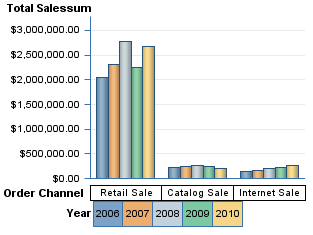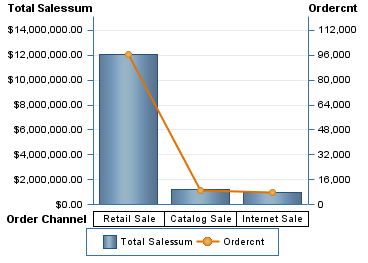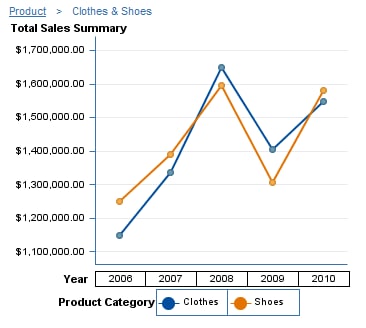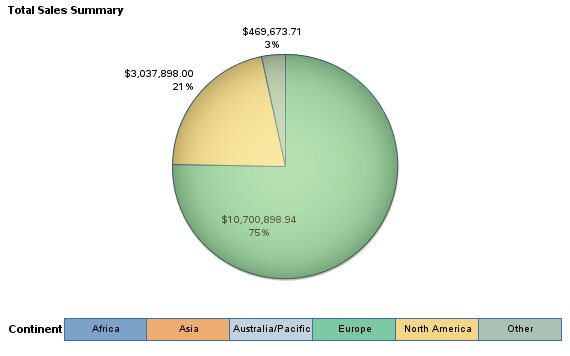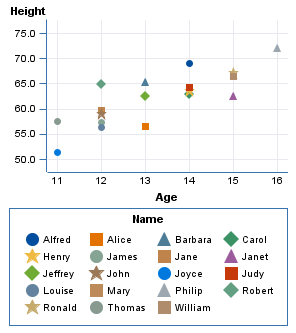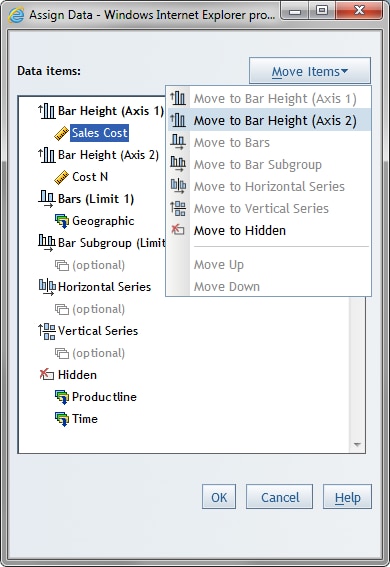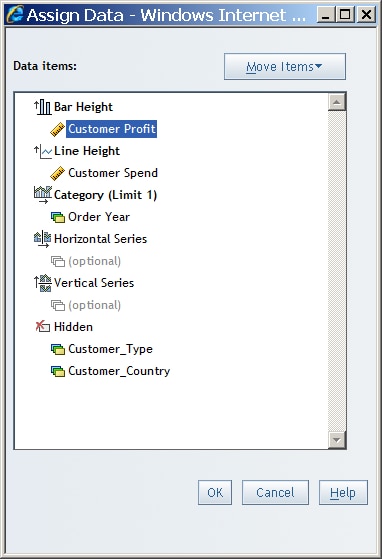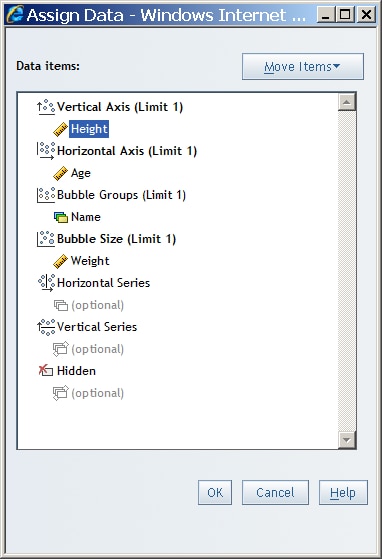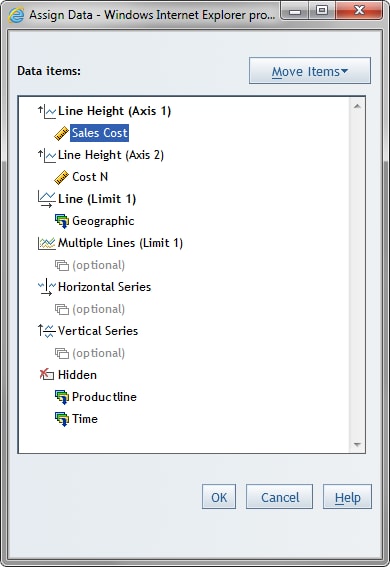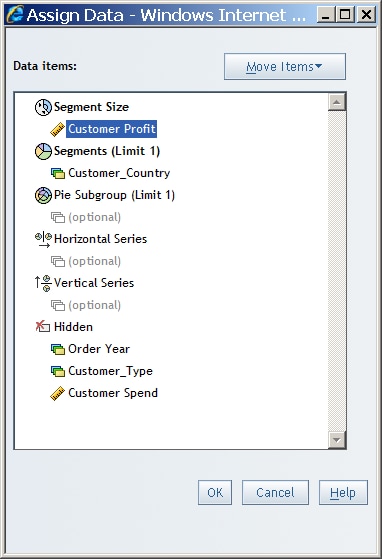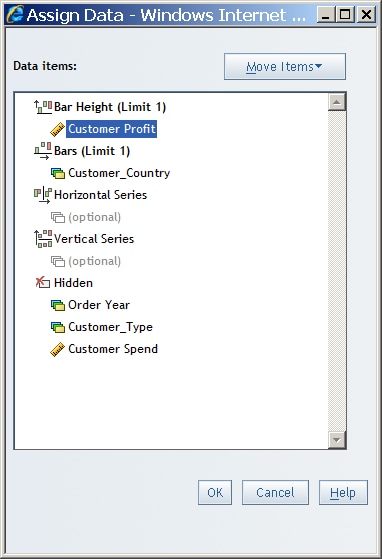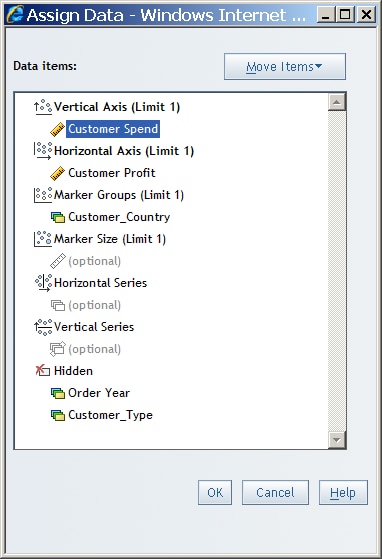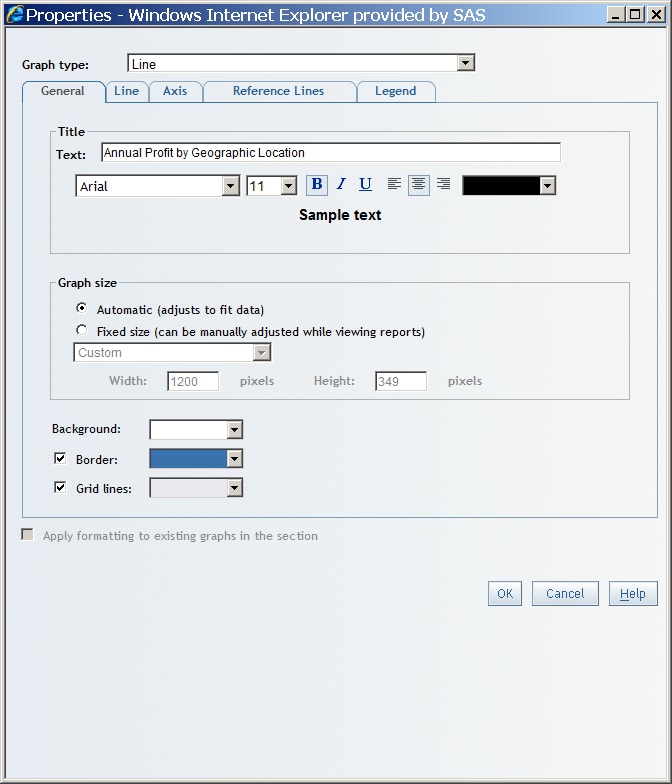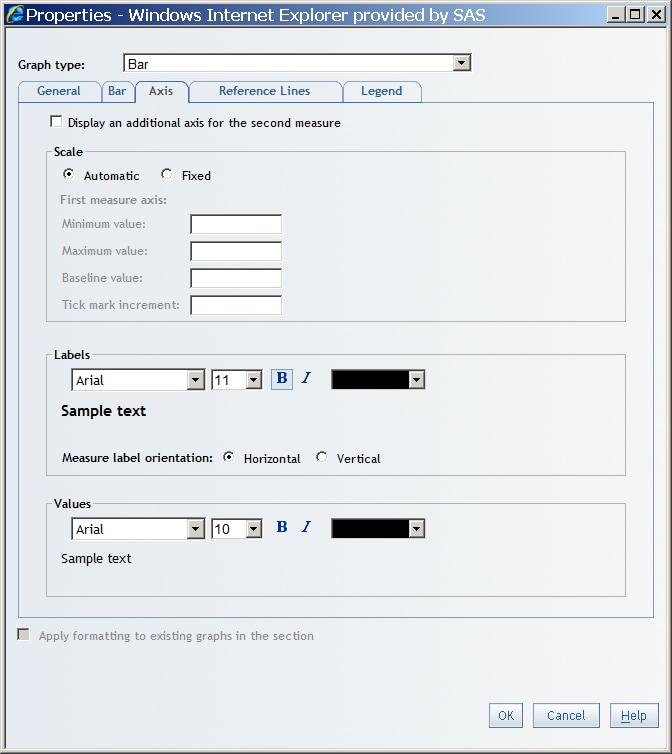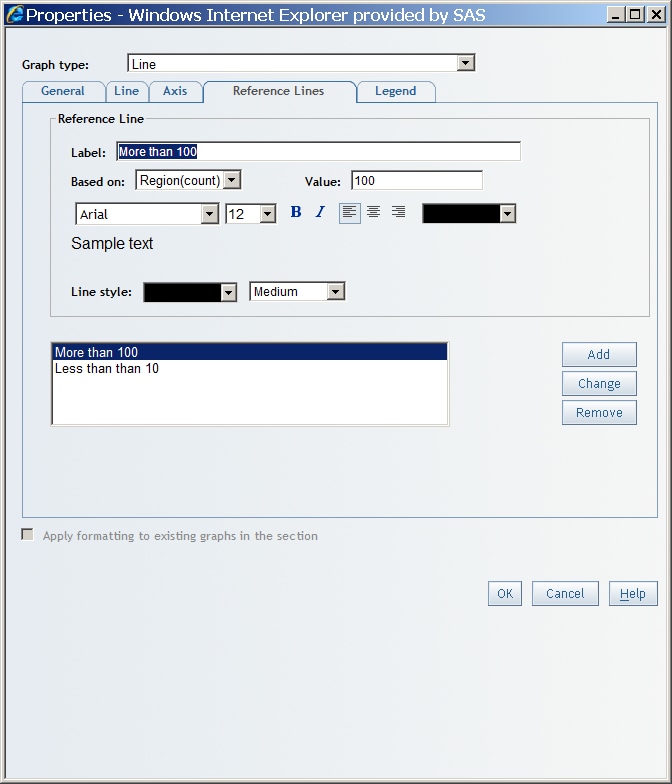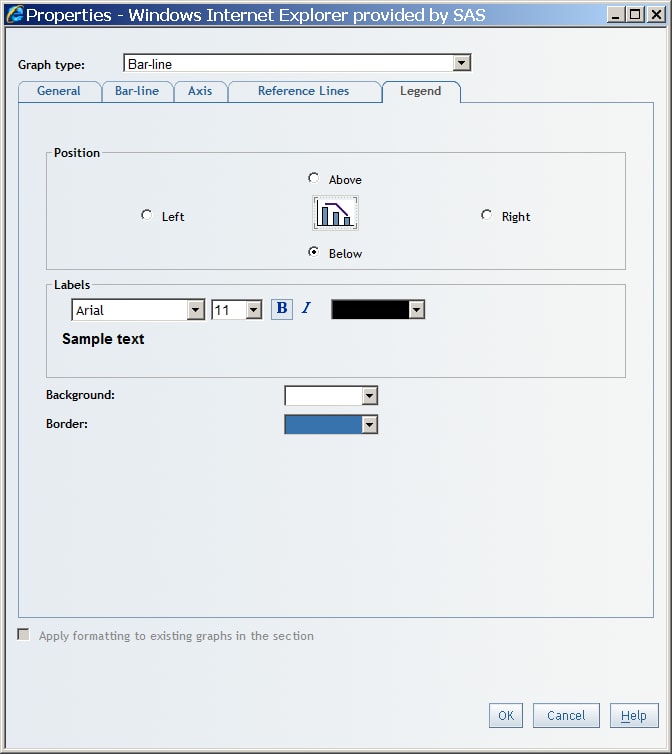Using Graphs to Display Query Results
Overview of the Graph Types
About Progressive Bar Charts
A progressive
bar chart shows how the initial value of a measure increases
or decreases during a series of operations or transactions. The first
bar begins at the initial value, and each subsequent bar begins where
the previous bar ends. The length and direction of a bar indicates
the magnitude and type (positive or negative, for example) of the
operation or transaction. The resulting chart is a stepped cascade
that shows how the transactions or operations lead to the final value
of the measure.
A Progressive Bar Chart
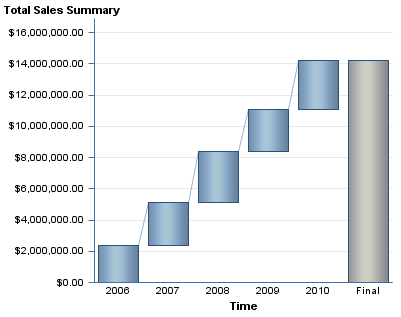
About Bubble Plots
A bubble
plot is a variation of a scatter plot in which the markers
are replaced with bubbles. In a bubble plot, each bubble represents
an observation. The location of the bubble represents the value for
the two measure axes; the size of the bubble represents the value
for the third measure. A bubble plot is useful for data sets with
dozens to hundreds of values or when the values differ by several
orders of magnitude. You can also use a bubble plot when you want
specific values to be more visually represented by different bubble
sizes.
A Bubble Plot
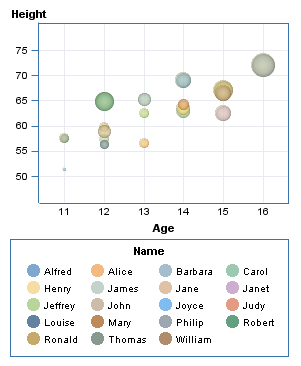
About Tile Charts
A tile
chart is divided into rectangular areas. The color of
each area represents the value of the first measure in the query.
The size of each area represents the value of the second measure in
the query. For example, a tile chart might be used to represent sales
data where the tile sizes vary according to the number of orders invoiced
and the tile colors are derived from a color gradient that represents
low to high sales figures.
A Tile Chart
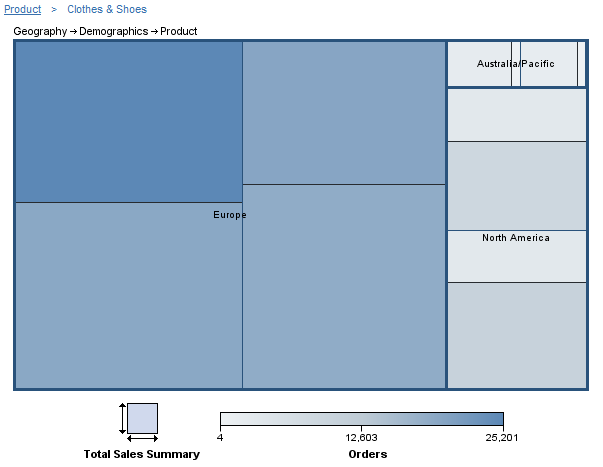
Insert a Graph into a Report Layout
Note: If you selected either of
the detail data options in the Summarization Options dialog
box, then the only graph types available are a scatter plot or a bubble
plot. For more information, see Use Detail Data Instead of Grouped and Aggregated Data.
Data items in the section
query are given the default assignments (see the following table)
in a new graph.
You can change the default
data assignments. For example, a bar chart uses a
Sales measure
to determine the bar height. You also want to assign Unit
Cost, which has been hidden by default, to bar height.
For more information, see Specifying How Data Items Are Used in Graphs.
Graphs also have default
properties that you can change. For example, by default, graphs do
not have titles. To create a title, open the Properties dialog
box and enter text in the Title field on
the General tab. For more information, see Create or Modify a Graph Title.
Tip
In general, the defaults for
properties that are related to style (for example, font and color)
depend on the currently applied report style.
Specifying How Data Items Are Used in Graphs
Assign Data Items to Bar Charts
To assign data items
to a bar chart, complete these steps:
-
The following data assignments are available for bar charts:Bar Height (Axis 1)Select at least one measure that will determine the height of each bar. You can add additional measures to Bar Height (Axis 1). However, if you assign more than one measure to Bar Height (Axis 1), then you cannot add a category or hierarchy to Bar Subgroup. Bar Height (Axis 1) is required.Typically, Bar Height (Axis 1) appears on the left and Bar Height (Axis 2) appears on the right of the bar chart. However, if the orientation property for the bar chart is set to Horizontal bars, then Bar Height (Axis 1) appears on the top and Bar Height (Axis 2) appears on the bottom of the bar chart.Bar Height (Axis 2)Specify one or more measures that will determine the height of each bar. You can add additional measures to Bar Height (Axis 2). Bar Height (Axis 2) is optional.Typically, Bar Height (Axis 1) appears on the left and Bar Height (Axis 2) appears on the right of the bar chart. However, if the orientation property for the bar chart is set to Horizontal bars, then Bar Height (Axis 1) appears on the top and Bar Height (Axis 2) appears on the bottom of the bar chart.Bars (Limit 1)Select a category or hierarchy, each value of which will be represented by one or more bars. Bars is required.Bar Subgroup (Limit 1)You can subdivide each bar across the values assigned to the category or the hierarchy. However, you cannot assign a category to Bar Subgroup if you have assigned more than one measure to Bar Height.Horizontal SeriesYou can create separate bar charts for each value of a selected category or hierarchy. The charts appear side by side. For example, if you select a Gender category for the horizontal series, a chart for each value of Gender is displayed side by side.Vertical SeriesYou can create separate bar charts for each value of a selected category or hierarchy. The charts appear stacked one on top of the other. For example, if you select a Gender category for the vertical series, a chart for each value of Gender is stacked vertically.HiddenData items that are assigned to Hidden do not appear in the bar chart but can be used in filtering. For more information, see Hiding Data Items.
Assign Data Items to Bar-Line Charts
To assign data items
to a bar-line chart, complete these steps:
-
The following data assignments are available for bar-line charts:Bar HeightSpecify one or more measures that will be used to determine the height of each bar. Bar Height is required.Line HeightSelect one or more measures that will be used to determine the height of the line at each bar. Line Height is required.Category (Limit 1)Select a category or hierarchy, each value of which will be represented by one or more bars and one or more lines. Category is required.Horizontal SeriesYou can create separate bar-line charts for each value of a selected category or hierarchy. The charts appear side by side. For example, if you select a Gender category for the horizontal series, a chart for each value of Gender is displayed side by side.Vertical SeriesYou can create separate bar-line charts for each value of a selected category or hierarchy. The charts appear stacked one on top of the other. For example, if you select a Gender category for the vertical series, a chart for each value of Gender is stacked vertically.HiddenData items that are assigned to Hidden do not appear in the bar-line chart but can be used in filtering. For more information, see Hiding Data Items.
Assign Data Items to Bubble Plots
To assign data items
to a bubble plot, complete these steps:
-
The following data assignments are available for bubble plots:Vertical Axis (Limit 1)Specify the measure that will be used to determine the vertical position of each bubble. Vertical Axis is required.Horizontal Axis (Limit 1)Select the measure that will be used to determine the horizontal position of each bubble. Horizontal Axis is required.Bubble Groups (Limit 1)Select a category or hierarchy, each value of which will be a set of bubbles. Bubble Groups is required for multidimensional data sources. If detail data is used, then this assignment groups and colors the data points. If aggregated data is used, there is one point for each data value in the category or hierarchy.Bubble Size (Limit 1)Select the measure that will be used to determine the size of each bubble. Bubble size is required.Horizontal SeriesYou can create separate bubble plots for each value of a selected category or hierarchy. The charts appear side by side. For example, if you select a Gender category for the horizontal series, a chart for each value of Gender is displayed side by side.Vertical SeriesYou can create separate bubble plots for each value of a selected category or hierarchy. The charts appear stacked one on top of the other. For example, if you select a Gender category for the vertical series, a chart for each value of Gender is stacked vertically.HiddenData items that are assigned to Hidden do not appear in the bubble plot but can be used in filtering. For more information, see Hiding Data Items.
Assign Data Items to Line Graphs
To assign data items
to a line graph, complete these steps:
-
Use the Move Items drop-down list to assign data items.Perform one of these tasks to assign data items:The following data assignments are available for line graphs:Line Height (Axis 1)Select at least one measure that will determine the height of each plot point along the line. There is no limit to the number of measures that you can assign to Line Height (Axis 1). However, consider graph appearance and report performance when assigning multiple measures to this data role. In addition, if you assign more than one measure to Line Height (Axis 1), then you cannot assign a category or hierarchy to Multiple Lines. Line Height (Axis 1) is required.Line Height (Axis 2)Select one or more measures that will determine the height of each plot point along the line. There is no limit to the number of measures that you can assign to Line Height (Axis 2). However, consider graph appearance and report performance when assigning multiple measures to this data role. Line Height (Axis 2) is optional.Line (Limit 1)Select a category or hierarchy, each value of which will be represented by a plot point on the lines shown in this graph. Line is required.Multiple Lines (Limit 1)You can subdivide the line into several lines, one for each value of the category or hierarchy that you assign to this data role. However, you cannot use Multiple Lines if you have assigned more than one measure to Line Height (Axis 1).Horizontal SeriesYou can create separate line graphs for each value of a selected category or hierarchy. The charts appear side by side. For example, if you select a Gender category for the horizontal series, a chart for each value of Gender is displayed side by side.Vertical SeriesYou can create separate line graphs for each value of a selected category or hierarchy. The charts appear stacked one on top of the other. For example, if you select a Gender category for the vertical series, a chart for each value of Gender is stacked vertically.HiddenData items that are assigned to Hidden do not appear in the line graph but can be used in filtering. For more information, see Hiding Data Items.
Assign Data Items to Pie Charts
To assign data items
to a pie chart, complete these steps:
-
The following data assignments are available for pie charts:Segment SizeSelect at least one measure that will determine the size of each segment. There is no limit to the number of measures that you can assign to Segment Size. However, consider graph appearance and report performance when assigning multiple measures to this data role. In addition, if you assign more than one measure to Segment Size, then you cannot add a category or hierarchy to Pie Subgroup. Segment Size is required.Segments (Limit 1)Select a category or hierarchy, each value of which will be represented by a segment. Segments is required.Pie Subgroup (Limit 1)You can subdivide the pie chart into a stack of pie charts, one for each value of the category or hierarchy that you assign to Pie Subgroup. However, you cannot use Pie Subgroup if you have assigned more than one measure to Segment Size.Horizontal SeriesYou can create separate pie charts for each value of a selected category or hierarchy. The charts appear side by side. For example, if you select a Gender category for the horizontal series, a chart for each value of Gender is displayed side by side.Vertical SeriesYou can create separate pie charts for each value of a selected category or hierarchy. The charts appear stacked one on top of the other. For example, if you select a Gender category for the vertical series, a chart for each value of Gender is stacked vertically.HiddenData items that are assigned to Hidden do not appear in the pie chart but can be used in filtering. For more information, see Hiding Data Items.
Assign Data Items to Progressive Bar Charts
To assign data items
to a progressive bar chart, complete these steps:
-
The following data assignments are available for progressive bar charts:Bar Height (Limit 1)Specify the measure that will be used to determine the height of each bar. Bar Height is required.Bars (Limit 1)Select a category or hierarchy, each value of which will be represented by a bar. Bars is required.Horizontal SeriesYou can create separate progressive bar charts for each value of a selected category or hierarchy. The charts appear side by side. For example, if you select a Gender category for the horizontal series, a chart for each value of Gender is displayed side by side.Vertical SeriesYou can create separate progressive bar charts for each value of a selected category or hierarchy. The charts appear stacked one on top of the other. For example, if you select a Gender category for the vertical series, a chart for each value of Gender is stacked vertically.HiddenData items that are assigned to Hidden do not appear in the progressive bar chart but can be used in filtering. For more information, see Hiding Data Items.
Assign Data Items to Scatter Plots
To assign data items
to a scatter plot, complete these steps:
-
The following data assignments are available for scatter plots:Vertical Axis (Limit 1)Specify the measure that will be used to determine the vertical position of each marker. Vertical Axis is required.Horizontal Axis (Limit 1)Select the measure that will be used to determine the horizontal position of each marker. Horizontal Axis is required.Marker Groups (Limit 1)Select a category or hierarchy, each value of which will be a set of markers. If detail data is used, then Marker Groups groups and colors the data points. If aggregated data is used, then there is one point for each data value in the category or hierarchy. Marker Groups is required for multidimensional data.Horizontal SeriesYou can create separate scatter plots for each value of a selected category or hierarchy. The charts appear side by side. For example, if you select a Gender category for the horizontal series, a chart for each value of Gender is displayed side by side.Vertical SeriesYou can create separate scatter plots for each value of a selected category or hierarchy. The charts appear stacked one on top of the other. For example, if you select a Gender category for the vertical series, a chart for each value of Gender is stacked vertically.HiddenData items that are assigned to Hidden do not appear in the scatter plot but can be used in filtering. For more information, see Hiding Data Items.
Assign Data Items to Tile Charts
To assign data items
to a tile chart, complete these steps:
-
The following data assignments are available for tile charts:CategoriesSelect one or more categories or hierarchies whose values determine the number of tiles and their arrangement. Each tile is associated with a value for each of the categories that it represents. There is no limit to the number of categories or hierarchies that you can assign to Categories. However, consider graph appearance and report performance when assigning multiple categories or hierarchies to this data role. Categories is required.Size (Limit 1)Select the measure whose values are used to determine the size of each tile. Size is required.Color (Limit 1)Select the measure whose values are used to create the gradient colors in the chart. To specify colors for low, medium, and high values, use the Properties dialog box. The default colors are based on the currently applied report style. If you do not assign a measure to Color, then the measure that is assigned to Size is also used to determine the colors.Auxiliary Data TipsSelect one or more measures whose values you want to display as data tips. There is no limit to the number of measures that you can assign to Auxiliary Data Tips. However, consider report performance when assigning many measures to this data role. Data tip values for the categories, color and size measures, and auxiliary data tip measures appear when you move the mouse over a tile.HiddenData items that are assigned to Hidden do not appear in the tile chart but can be used in filtering. For more information, see Hiding Data Items.
Create or Modify a Graph Title
Specify the Size of a Graph
To change the size
of a graph, complete these steps:
-
Under Graph size, select one of these options (depending on the graph type):Automatic (adjust to fit data) (all graph types except tile charts)Select this option to produce a graph that best fits the size of the current window. This option is the default.Fixed size (can be manually adjusted while viewing reports) (for all graph types except tile charts)Select this option if you want to specify a fixed size for the graph. From the drop-down list, select Small, Medium, Large, or Custom. If you select Custom, you can type the width and height in pixels. The maximum width is 1200 pixels. The maximum height is 900 pixels.TipIf you select the Fixed size option, you can use your mouse to resize the graph in View mode. In View mode, point to the bottom right corner or to the bottom or right border. When the pointer becomes a horizontal, vertical, or diagonal bar, you can drag the graph to the new size and then release the mouse button.
Specify the Border and the Border Color of a Graph
By default, graph borders
are turned off. To specify a border and border color of a graph, complete
these steps:
-
(Optional) Select the Border drop-down list to open the color palette. Then select a border color for the graph. You can customize a color using the Color value field. For more information, see Customizing Colors.
Specify the Background Color of a Graph
You can specify a background
color for all graph types except tile charts. To specify a background
color, complete these steps:
-
Select the Background drop-down list to open the color palette. Then select a background color for the graph. You can customize a color using the Color value field. For more information, see Customizing Colors.
Turn Grid Lines On or Off
Grid lines are available
for all graph types except pie charts and tile charts. To turn grid
lines on or off and to specify a color for the lines, complete these
steps:
-
If you are showing grid lines, select the Grid lines drop-down list to open the color palette. Then select a color. You can customize a color using the Color value field. For more information, see Customizing Colors.
Specify the Scale Type and Style of the Axis
You can specify axis
properties for all graph types except pie charts and tile charts.
To specify properties, complete these steps:
-
When you have group breaks, the axis on one chart (or graph) might differ from the axis on another chart (or graph). For example, one measure axis on a bar chart might have values from 10 to 400, while another axis might have values from 10 to 600 coming from the data source. When you select Fixed, you can set the minimum and maximum values so that the axes on both bar charts become the same. Then, when you look at the height of the bars in both charts, you will be making a similar comparison.
Add, Modify, or Remove Reference Lines
You can add, modify,
or remove reference lines for all graph types, except pie charts or
tile charts. For example, a reference line could be added to indicate
a sales goal or a voting age.
Tip
Before entering reference
lines, find out what the default scale values are by displaying the
graph in View mode.
To add reference lines,
complete these steps:
Specify the Position, Label Style, and Background Color of the Legend
Legend properties
are available for all graph types except progressive bar charts. However,
bar charts, bubble plots, line graphs, scatter plots, and tile charts
must meet certain requirements for the legend properties to be available,
as follows:
To specify legend properties,
complete these steps:
-
For bar charts, pie charts, bar-line charts, line graphs, and scatter plots, select the Background drop-down list to open the color palette. Then select a background color for the graph. You can customize a color using the Color value field. For more information, see Customizing Colors.
-
(Optional) Select the Border drop-down list to open the color palette. Then select a border color for the graph. You can customize a color using the Color value field. For more information, see Customizing Colors.
Copy the Formatting of a Selected Graph
To copy the formatting
of a selected graph to other graphs in the report section, complete
these steps:
-
Select the check box to specify that you want the formatting applied to other graphs in the section. Depending on the graph type, one of these options will display:Apply formatting to existing graphs in the section (all graph types except tile charts)Formatting properties that are copied include title style, background color, border color, marker size, bar shape, the option to display a second measure axis, measure label orientation, the option to display data labels, and legend style.
Change the Currently Selected Graph Type
Except for tile charts,
you can change a selected graph from one type to another. Complete
these steps:
The data item assignments
and properties are changed to match the new graph type. For example,
suppose that you have a pie chart and a Year data
item is assigned to Pie Subgroup in the Assign
Data dialog box. If you change the pie chart to a progressive
bar chart, the Year data item
becomes hidden because a progressive bar chart does not have a subgroup
data role.
Specifying Properties That Are Specific to a Graph Type
Specify Properties That Are Specific to a Bar Chart
Specify Properties That Are Specific to a Bar-Line Chart
Specify Properties That Are Specific to a Bubble Plot
Specify Properties That Are Specific to a Line Graph
Specify Properties That Are Specific to a Pie Chart
To specify properties
that are specific to a pie chart, complete these steps:
-
(Optional) Under Values, specify one or more of these options, and then specify the font, font size, font style, and font color:Combine minimal values into a slice labeled "Other"This option is selected by default. You can also specify the percent to use as minimal value. The default value is 4%. For example, if you specify 2% and there are two or more pie slices that each have less than 2% of the total, then these slices are combined into a single slice labeled "Other".
Specify Properties That Are Specific to a Progressive Bar Chart
To specify properties
that are specific to a progressive bar chart, complete these steps:
-
Under the Colors heading, select a color for each type of bar that appears in the chart. Select the Positive bars, Negative bars, Initial bar, or Final bar drop-down list to open the color palette. Then select a color for the bar. You can customize a color using the Color value field. For more information, see Customizing Colors.
Specify Properties That Are Specific to a Scatter Plot
Specify Properties That Are Specific to a Tile Chart
To specify properties
that are specific to a tile chart, complete these steps:
-
From the Layout type drop-down list, select one of these options:StandardSpecifies a standard layout tile chart that ignores sort order and keeps the tiles as close to squares as possible.ToggleSpecifies a simple layout that divides a variable’s associated tiles in a single dimension, and switches the orientation as each level is placed. This layout works best with small amounts of data. For large amounts of data, use Flow.FlowSpecifies a layout in which the available space is divided into a number of rows of similar but not equal heights. The number of rows is computed based on the number of tiles that will be displayed in conjunction with the aspect ratio of the available space. Then, the ordered tiles are placed in the rows from top to bottom and left to right. At each level, you can read the tiles like a page in a book.
-
For tile charts that are based on relational data sources, you can specify the levels of data that you want to appear. From the Show data levels drop-down list, specify the number of levels of detail (that is, the number of times that the chart is divided). You can show 1 or 2. The default is 2, unless there is only one category. In that case, the default is 1.
-
Under the Color heading, select a color for the low, medium, and high values in the tile chart. Select the Low value, Medium value, or High value drop-down list to open the color palette. Then select a color for the value. You can customize a color using the Color value field. For more information, see Customizing Colors.
